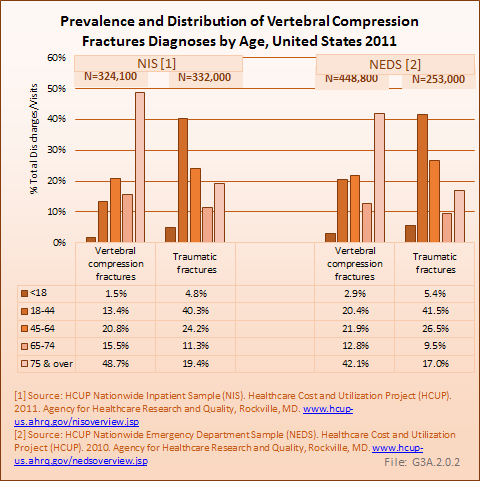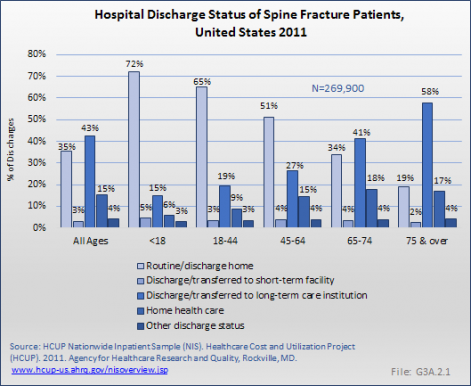

Based on the HCUP Nationwide Inpatient Sample (NIS) and Nationwide Emergency Department Sample (NEDS) databases queried, there were an estimated 795,300 hospital discharges and emergency department visits for spinal fractures in 2010–/2011. Nearly three out of five spinal fractures occurred in women.
The great majority of hospital/ED combine spinal fracture patients (773,000, or 97%) were treated for vertebral compression fractures (VCF), and more than one-half (58%) involved women. Nearly half of discharges and visits for VCFs were for persons age 75 years and older.
Traumatic fractures were far less common, with 27,100 (3%) hospital discharges or outpatient visits reported in the 2010–2011 Heathcare Cost and Utilization (HCUP) databases. Numbers were too small for reliable reporting in the National Center for Health Statistics (NCHS) databases, which include outpatient and physician office visits. Traumatic fractures predominantly involve men (about 60%), and are most likely to involve patients between the ages of 18 and 44 years. These are coarse estimates, as some ED patients are admitted (samples may overlap and overestimate), while outpatient visits are not included. (Reference Table 3.1.1 PDF [1] CSV [2] and Table 3.1.2 PDF [3] CSV [4])

Discharge status from the hospital had a direct and linear correlation with age. For patients under 18 years of age, 72% were discharged home while only 15% were discharged to a long-term facility. The discharge status progressively changed with increasing age so that, for patients age 75 years and older, 19% were discharged home while 58% were discharged to a long-term facility. Although the overall rate of patients discharged to long-term care is slightly higher than for traumatic fractures than for VCF (54% vs. 42%), the age correlation appears to be independent of fracture severity because younger patients likely had more severe fractures. (Reference Table 3.3.1 PDF [5] CSV [6] and Table 3.3.3 PDF [7] CSV [8]) (G3A.2.1)
Links:
[1] https://bmus.latticegroup.com/docs/T3.1.1.pdf
[2] https://bmus.latticegroup.com/docs/T3.1.1.csv
[3] https://bmus.latticegroup.com/docs/T3.1.2.pdf
[4] https://bmus.latticegroup.com/docs/T3.1.2.csv
[5] https://bmus.latticegroup.com/docs/T3.3.1.pdf
[6] https://bmus.latticegroup.com/docs/T3.3.1.csv
[7] https://bmus.latticegroup.com/docs/T3.3.3.pdf
[8] https://bmus.latticegroup.com/docs/T3.3.3.csv